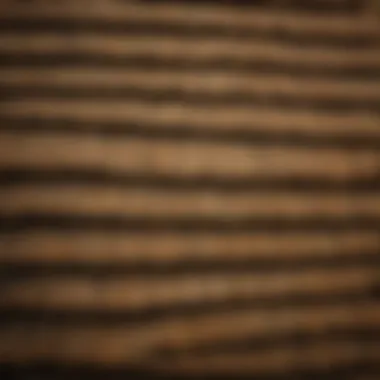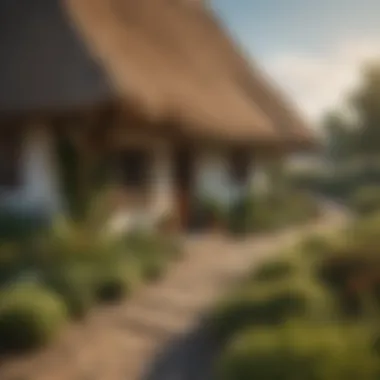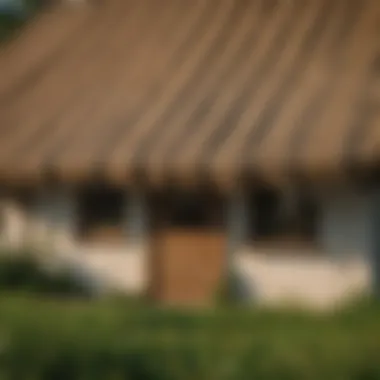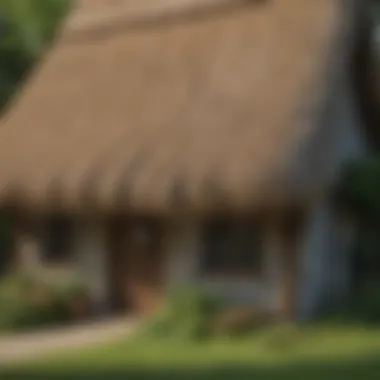Exploring the Longevity of Thatched Roofs


Intro
Thatched roofs represent a unique blend of tradition and functionality. This roofing method, often associated with historical and rural buildings, continues to capture the interest of architects and homeowners alike. Understanding the longevity of thatched roofs is crucial for making informed decisions regarding construction and maintenance. The durability of these roofs largely depends on various factors, such as the materials used, environmental conditions, and maintenance practices.
In this article, we will delve into the intricacies of thatched roofs. We will explore traditional materials employed in thatching, the external influences on their longevity, and established industry standards for installation and care. The aim is to clarify misconceptions about thatched roofs and provide actionable insights for preserving this age-old roofing technique.
Factors Affecting Longevity
To comprehensively understand the lifespan of thatched roofs, several factors must be examined:
- Material Quality: The type of thatch material significantly affects durability. Varieties such as water reed, long straw, and wheat reed each have distinct lifespans and characteristics.
- Installation Techniques: Proper installation is vital. An experienced thatcher adheres to techniques ensuring maximum water resistance and air circulation, which influence how long a roof will last.
- Environmental Conditions: Weather plays a critical role. High humidity and temperature fluctuations can accelerate decay, whereas optimal ventilation can mitigate damage.
- Maintenance Practices: Regular inspections and maintenance will prolong the life of a thatched roof, addressing issues like pests and water ingress.
"A well-maintained thatched roof can last several decades, sometimes outlasting improperly installed modern roofs."
Now, let's move to the materials used in thatching and their respective advantages.
Traditional Materials Used in Thatching
Thatching involves various materials, each offering unique benefits:
- Water Reed: Known for its durability, water reed can last up to 40 years with proper installation and care. It is particularly effective in wet climates.
- Long Straw: While more affordable, long straw generally has a shorter lifespan of approximately 20 years. It is commonly used in areas with drier conditions.
- Wheat Reed: Wheat reed provides a more rustic appearance and has a good lifespan, often ranging from 25 to 30 years.
Each material has its unique qualities, impacting not only the longevity but also the aesthetic appeal of the roofing solution. Choosing the right material depends on geographical location, climate, and personal preference.
Maintenance Practices
Effective maintenance is crucial for maximizing the lifespan of thatched roofs:
- Regular Inspections: Frequent checks for signs of wear, damage, or pest activity can help catch issues early.
- Clearing Debris: Removing leaves and branches can help prevent moisture accumulation and encourage airflow.
- Trimming Overhanging Branches: This minimizes the risk of vegetation causing damage during storms.
- Professional Care: Engaging with skilled thatchers for repairs is essential. Their expertise can ensure repairs match the existing structure, thus maintaining integrity and aesthetics.
Explore more about thatched roofs here.
Prelude to Thatched Roofs
Thatched roofs represent a timeless architectural choice, merging aesthetics with functionality. They have a long history and culturally significant presence across various regions. Importantly, the longevity of such roofs correlates closely with the materials used and the practices surrounding their installation and maintenance.
Understanding thatched roofs starts with recognizing their historical context. This sheds light on their enduring popularity. In addition, this section addresses common materials that contribute to a roof's lifespan. Homeowners and builders can gain insightful perspectives here, enabling informed decisions when selecting thatching materials.
With the growing environmental consciousness today, using natural materials for roofing aligns with sustainable practices. This makes thatched roofs not only appealing from a design standpoint, but also relevant for modern ecological considerations. This section serves as a foundation for the subsequent detailed analysis of longevity regarding thatched roofs.
Typical Lifespan of Thatched Roofs
The longevity of thatched roofs is a critical aspect of their overall appeal and functionality. Understanding typical lifespans, alongside the various factors that affect durability, informs both homeowners and builders. This section will delve into the average longevity based on materials, and key influences that can determine how long these roofs can endure under different conditions.
Average Longevity Based on Material
The average lifespan of thatched roofs varies significantly based on the materials used. Generally, roofs made from traditional materials such as straw may last around 15 to 25 years, while those constructed from stronger materials like water-flag reeds can extend to 30 years or more. The choice of material directly influences not only the aesthetic value but also the maintenance needs over time. For homeowners, it is crucial to consider these longevity estimates when planning installations, ensuring that choices align with both budget and long-term goals.
Factors Influencing Lifespan
Several elements impact the overall lifespan of thatched roofs. Among those, the quality of materials, installation techniques, and environmental conditions stand out as the most tangible factors.


Quality of Materials
The quality of materials used in thatching determines a roof's durability. High-quality straw, for instance, tends to be thicker and have a better natural resistance to moisture and pests. The more robust the material, the less likely it will suffer from rot or structural failure. A key characteristic of high-quality materials is their water-repellent nature, which directly contributes to their longevity. Poor quality materials, on the other hand, may lead to frequent repairs and shorten the lifespan significantly.
Installation Techniques
Proper installation is equally vital for ensuring a long-lasting thatched roof. Skilled thatchers use specific techniques to enhance the structure's resilience against the elements. One notable method involves layering thatch in a way that promotes drainage. This is beneficial as it prevents water accumulation, which can lead to decay over time. Alternatively, poor installation practices can leave a roof vulnerable to issues that may otherwise be avoidable, directly impacting its lifespan.
Environmental Conditions
Environmental conditions heavily influence the lifespan of a thatched roof. Areas with high humidity or substantial rainfall may see roofs deteriorate faster than those placed in drier climates. For example, damp climates can promote the growth of mold, affecting both aesthetics and structural integrity. Seasonal changes also play a part; frequent temperature fluctuations can put stress on the materials, leading to cracks and other forms of damage. Understanding local climate characteristics is essential for anyone considering a thatched roof, as it can affect maintenance routines and overall longevity.
"The longevity of thatched roofs is not solely about the materials or methods used; it also greatly depends on understanding the environment they inhabit."
In summary, the typical lifespan of thatched roofs is a multifaceted subject that ranges from material quality to environmental factors. Homeowners should weigh these considerations carefully, keeping in mind that informed choices will enhance both the aesthetic and functional lifespan of their roofs.
Regional Variations in Thatched Roofing
Understanding the regional variations in thatched roofing is essential, as it influences the techniques used, the materials chosen, and the longevity of roofs. Different climates and cultures adopt specific practices that impact the overall performance of thatched roofs. For homeowners or builders considering thatched roofing, knowing these variations helps in making informed decisions. It ensures that the roofs not only complement the architectural aesthetic but also withstand the environmental challenges they present.
Climate Impacts on Longevity
Damp Climates
Damp climates significantly affect the longevity of thatched roofs. They often present a higher risk of mold and decay due to moisture retention. Thatching in these areas usually relies on materials like reeds that have better resistance to moisture. The key characteristic of damp climates is consistent humidity, which can lead to a shorter lifespan of thatched roofs if not appropriately maintained. It is a popular concern within the article, as homeowers must conduct regular inspections to mitigate damage. The unique challenge here is the balance between maintaining the thatch and ensuring proper drainage to prolong roof life.
Dry Climates
In contrast, dry climates offer different advantages and challenges. These environments can extend the lifespan of thatched roofs due to reduced moisture levels, which lessens the risk of rot. The primary characteristic is aridity, which leads to lower maintenance needs over time. However, thatched roofs in dry climates can suffer from cracking or damage due to intense UV exposure. This aspect is critical since it emphasizes the need for preventative measures like periodic brushing to maintain the thatch structure. Overall, dry climates are seen as more favorable for thatching due to their conducive conditions for longevity.
Seasonal Changes
Seasonal changes play a crucial role in the lifecycle of thatched roofs. Variability in weather can lead to different stresses on the thatching materials. For instance, a cold winter can stiffen the materials while a warm summer may cause expansion. The unique feature of seasonal changes is that they offer both advantages and disadvantages. Homeowners in regions experiencing marked seasonal shifts must be vigilant about the potential impacts on their roofs. Having a strategy for maintenance that accounts for these changes is beneficial and can enhance roof durability over time.
Cultural Influences on Thatching Techniques
Cultural influences have historically shaped the techniques employed in thatching. Different regions have developed their own methods based on the available materials and local building traditions. This aspect of thatching often results in variations in the preferred style and longevity of roofs. The choices made in thatching techniques show how local customs can contribute to both aesthetic value and practical performance in roofing systems. Understanding these cultural approaches provides insight into how local knowledge can sustain roofing practices for generations.
Maintenance and Care for Thatched Roofs
The longevity of thatched roofs depends heavily on regular maintenance and care. This aspect is often overlooked but plays a crucial role in preserving the aesthetic and structural integrity of these roofs. Proper maintenance can prevent major repairs and extend the lifespan of a thatched roof significantly. Homeowners who invest time and resources in maintaining their thatched roofs will likely find they can enjoy their unique charm for many years.
Regular Maintenance Practices
Cleaning procedures
Regular cleaning is essential for maintaining thatched roofs. One specific aspect of cleaning procedures involves removing organic debris, such as leaves, moss, and algae. This buildup can trap moisture, leading to accelerated deterioration of the thatch. The key characteristic of these cleaning procedures is that they require careful handling to avoid damaging the thatch itself. Gentle brushing and hosing down with low-pressure water are typically effective while minimizing harm. This choice is beneficial because maintaining cleanliness is crucial to prevent decay and ensure proper drainage.
A unique feature of these cleaning procedures is the use of specialized brushes designed not to disturb the thatch too much. These brushes can effectively clean without causing damage, preserving the roof's natural appearance. However, one disadvantage might be the need for professionals who know how to clean thatched roofs appropriately, which could increase the overall maintenance cost.
Inspection routines
Routine inspections are another critical part of maintaining thatched roofs. This involves checking for signs of wear, damage, or pest infestation. The key characteristic of inspection routines lies in identifying potential problems before they escalate. This preventive approach is popular among homeowners wanting to secure their investments. Regular inspections inform the owner about the state of the roof and provide valuable insights for necessary maintenance tasks.


A unique feature of these routines is that they often encourage homeowners to go beyond visual checks. Technicians can use tools such as moisture meters to detect hidden issues. While this enhances the effectiveness of inspections, it also means that there might be additional costs associated with hiring skilled professionals.
Repair and Restoration Techniques
Identifying damage
Identifying damage is a fundamental step in the repair process. Homeowners must routinely assess their roofs for any signs of wear that could impact longevity. This task involves looking for missing thatch, loose materials, or other visible problems. The key characteristic of identifying damage is that it can often prevent more costly repairs later. Recognizing issues early positively contributes to the overall maintenance goal.
A unique feature of this process is that technological advancements have led to tools that help homeowners spot damages more efficiently. For example, infrared cameras can reveal temperature irregularities that indicate moisture issues. However, not all homeowners may have access to these tools, which might lead to delayed identification in some cases.
Patchwork methods
When damage is identified, patchwork methods come into play as an effective repair technique. This specific aspect involves replacing or repairing the damaged areas using similar materials to the original thatch. The key characteristic of patchwork methods is their ability to blend seamlessly with the existing roof. This approach is beneficial because it upholds both durability and aesthetic appeal.
A unique feature of patchwork methods is the focus on matching textures and colors of the thatch. This ensures that the repaired areas do not create noticeable differences in appearance. Nonetheless, the primary disadvantage is that these repairs may require skilled craftsmanship, which can lead to higher costs if done improperly.
Regular maintenance and timely repair are essential for ensuring the longevity of a thatched roof.
In summary, maintenance and care are pivotal in prolonging the lifespan of thatched roofs. Simple, regular cleaning and thorough inspection routines allow homeowners to address issues before they grow. Repair techniques, especially identifying damage and patchwork methods, complement these efforts, creating a comprehensive approach to thatched roof longevity. Homeowners who apply the suggested practices can ensure their thatched roofs remain beautiful and effective for many years.
Economic Considerations
The economic implications of thatched roofing are multifold and crucial for both homeowners and builders. Analyzing these considerations allows one to make informed decisions about investments in this traditional roofing method. The costs associated with thatched roofs encompass not only initial outlays but also long-term financial commitments regarding maintenance and potential repairs.
Initial Costs vs. Long-Term Investment
When evaluating thatched roofs, it is essential to understand the balance between initial costs and long-term investment. Thatching can seem more expensive upfront than conventional roofing. However, the longevity and aesthetic appeal may justify the higher price for many homeowners.
- Initial Costs: The initial costs of thatched roofing can be significant. The price often includes materials, labor, and additional fees related to compliance with building codes. Higher-quality materials, such as water flag and wheat straw, contribute to these costs. The expertise required for skilled installation also leads to increased labor expenses.
- Long-Term Investment: The long-term investment is often where thatched roofs distinguish themselves. Properly maintained thatched roofs can last decades—beyond the typical lifespan of asphalt or metal roofs. Homeowners may benefit from lower repair costs and fewer replacements over time. The unique aesthetic can also enhance property value, potentially leading to a return on investment during resale.
Insurance and Valuation
Understanding insurance considerations and property appraisal for thatched roofs is essential for economic viability. Many homeowners overlook these factors, which can influence both the insurability and overall valuation of a property.
Insurance Challenges
Insurance for thatched roofs poses unique challenges. Many standard home insurance policies are hesitant to cover thatched roofing due to perceived risks, particularly related to fire hazards. This results in higher premiums or exclusion from coverage altogether. Some insurers may require additional safety measures, such as the installation of fire-retardant coatings, which come at an added cost. Insurers also often request an inspection by a qualified thatching expert before coverage is granted.
- Key Characteristic: A distinguishing characteristic of insuring a thatched roof is the increased scrutiny it faces. Potentially high premiums may discourage some homeowners from opting for thatched roofing.
- Advantages/Disadvantages: While insuring a thatched roof may be challenging, potential homeowners must weigh these risks against the aesthetic and durability benefits that thatched roofs provide.
Appraisal Considerations
Appraisal considerations for properties with thatched roofs also differ from conventional roofing. Appraisers often struggle to find comparable properties, which may lead to inconsistent valuations. The unique appeal of thatched roofs may increase property value in certain markets, attracting niche buyers.
- Key Characteristic: The uniqueness of thatched roofs means they might not always fit into traditional appraisal models, complicating value assessments.
- Advantages/Disadvantages: On one hand, homes with well-maintained thatched roofs can command premium prices. On the other hand, if the roof requires significant repairs or shows signs of neglect, it can detract from property value.
Understanding the economic aspects of thatched roofs can enable homeowners and builders to make informed decisions that balance initial investment with long-term savings and property value.
Regulatory and Safety Issues
Regulatory and safety issues play a crucial role in the construction and maintenance of thatched roofs. Understanding these factors is essential for homeowners, builders, and enthusiasts in order to ensure longevity and safety. Compliance with relevant building codes and safety standards not only protects investments but also serves to minimize risks associated with thatching.
Building Codes and Standards


Building codes govern the materials and methods used in construction. In the case of thatched roofs, these codes may specify the types of materials approved for use, installation methods, and maintenance requirements. Adhering to building codes is particularly important because it helps ensure that the thatched roofs can withstand environmental pressures such as wind, rain, and even snow accumulation.
Moreover, regional codes often have specific provisions for thatched roofs due to their unique characteristics. For example, in some areas, professionals must obtain permits before installing a thatched roof. Homeowners should verify local regulations before construction to avoid potential fines or enforcement issues.
Fire Safety Protocols
Fire safety is a significant concern with thatched roofs. Given their organic nature, thatching materials like straw and reeds are flammable. For this reason, implementing fire safety protocols is vital for minimizing risks.
Certain standard measures should be adopted:
- Fire retardant treatments: Applying fire-retardant chemicals to thatching materials can significantly reduce flammability. It is highly recommended to consider this option during installation.
- Regular inspections: Homeowners must conduct frequent inspections of their roofs for any signs of damage or dry materials which could pose a fire hazard.
- Clearances: Maintaining clear areas around the roof where flammable debris cannot accumulate is also important. Items like branches or leaves should be routinely removed, especially after storms.
"Fire safety measures are not an option; they are a necessity for the longevity of a thatched roof."
Establishing adherence to both building codes and fire safety protocols creates a solid foundation for the longevity and safety of thatched roofs. Homeowners should actively engage with local regulations and prioritize safety protocols to protect their investment and enhance the comfort of their living spaces.
Epilogue
Conclusion serves as the capstone of this exploration into the longevity of thatched roofs, synthesizing insights gleaned from previous sections while emphasizing their practical implications for homeowners and builders. This roofing method, steeped in tradition, is not just about aesthetics but also entails significant considerations regarding its durability, care, and maintenance. The lifespan of thatched roofs is influenced by various factors, from the materials used to environmental conditions. Understanding these elements can guide property owners in making informed decisions.
Summary of Findings
In our examination, we uncovered several critical insights:
- Material Selection: The choice of thatching material plays a crucial role in determining longevity. Specific materials, such as wheat straw, exhibit robust durability, while others might require more frequent replacement.
- Environmental Factors: Each climate has unique impacts on roof longevity. For instance, roofs in damp climates may exhibit moss growth, which can accelerate decay, while dry regions can support longer-lasting thatch.
- Maintenance Routines: Regular inspection and maintenance are vital. Simple cleaning and timely repairs can significantly extend the lifespan of thatched roofs, preventing extensive damage.
These findings advocate for more than just an appreciation of thatched roofs; they stress the importance of proactive measures for care and inspection.
Final Thoughts on Care and Longevity
While thatched roofs can endure for decades under optimal conditions, their performance hinges upon proper care. Homeowners should prioritize regular inspections, focusing on potential wear and environmental damage. Combining traditional knowledge with modern practices can optimize roof care.
Furthermore, adapting maintenance strategies to local conditions highlights a vital approach. For example, homeowners in wetter areas should ensure efficient drainage and regularly clear debris to prevent rot.
References and Further Reading
The exploration of thatched roofs, particularly their longevity, necessitates a solid foundation of references and further reading. These resources not only bolster the credibility of the arguments presented but also allow readers to delve deeper into topics of interest. Providing a well-curated list of references is crucial for anyone wishing to gain a more nuanced understanding of the complexities surrounding thatched roofing.
Importance of References
In an age where misinformation can spread rapidly, having reliable sources is paramount. Well-researched articles and studies offer accountability and reliability. Engaging with reputable references enhances the reader's confidence in the material. For those who are considering thatching for their homes or simply interested in historic techniques, these references serve as a vital touchstone for in-depth understanding.
Benefits of Further Reading
- Extended Knowledge: Articles from sources like Britannica can provide historical context. Knowing the evolution of thatched roofing can enrich your appreciation of this craft.
- Practical Insights: Technical manuals and homeowner guides often contain step-by-step instructions and tips that are beneficial for maintenance. These insights can significantly improve the longevity of shared roofing structures.
- Cultural Context: Understanding the cultural significance of thatching in various regions can add another layer of depth to your comprehension. Cultural studies often detail the societal values tied to specific methods and materials.
- Case Studies: Reading about real-life applications helps inform decision-making. Testimonials or documented studies can outline the performance of thatched roofs across climates and materials, guiding prospective homeowners.
Key Considerations
- Always ensure sources are up-to-date and accurate. Misinformation can lead to poor decision-making.
- Diversifying your reading materials can offer various viewpoints.
- Look for peer-reviewed articles when available, as they typically undergo rigorous checks for accuracy.
"The best way to predict the future is to study the past." - Robert Oppenheimer
Suggested Resources
- Wikipedia on Thatching for a general overview and history.
- Britannica on Roofing Materials to understand various roofing options, including thatching.
- Reddit Threads for community insights and personal experiences.
- Facebook Groups dedicated to home improvement discussions where one can ask questions and share experiences about thatched roofs.
The End
Ultimately, references and further reading equip homeowners with the knowledge needed to make informed choices about thatched roofs. They open avenues for deeper understanding and long-term success in maintaining these historically rich structures.



